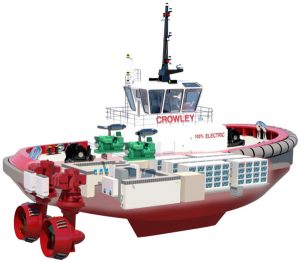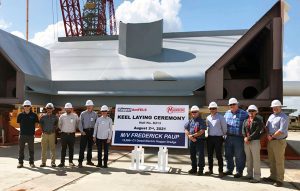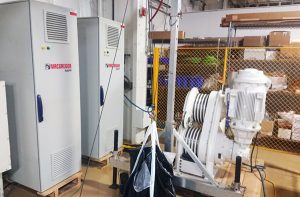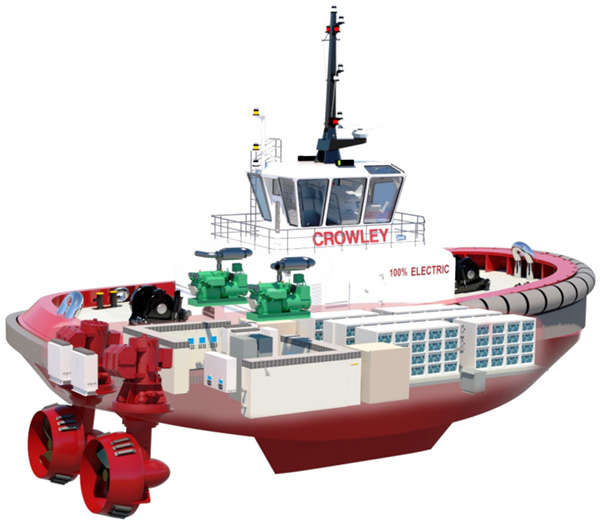
A good set of deck machinery is vitally important to the success of a vessel and the mariners that operate them.
The companies that produce this machinery continue to strive to improve the quality, efficiency and reliability of their products, and some have recently made major deliveries of new products for tugs, barges and other vessels on the Pacific coastline and elsewhere around the world.
In recent years, maintaining the natural environment has become a greater priority for deck machinery companies, and they’ve had the chance to work with cutting-edge ships, supporting novel efforts to reduce erosion, spear-heading deck equipment on the first zero-emissions tug in the United States, and a variety of other sustainable projects.
Deck machinery companies based on the West Coast or with a significant presence there that have stood out in recent times include Markey Machinery, MacGregor and Naust Marine, among others.
Here are some of the more noteworthy developments in deck machinery that have taken place in the past few years:
Markey
Seattle-based Markey Machinery was recently contracted by Crowley Maritime to install equipment in its new fully-electric, zero-emissions tug, the eWolf, which Crowley has said is the first of its kind in the United States.
Master Boat Builders, headquartered in Alabama, has been retained to install one 20,500 pound Markey model DEPC-48 Hawser Winches forward, a second DEPC-48 Hawser Winch aft, and the included drives and controls below decks.
The two DEPC-48 machines will function as advanced fully independent hawser winches with Markey render/recover controls.
“Crowley’s eWolf heralds the era of zero-emissions assist tugs for the maritime industry,” Markey President Blaine Dempke said of the contract. “Maritime’s choice of our model DEPC-48 speaks to the confidence they have in the operational reliability of Markey’s brand of machinery.”
When completed, the tug will be put to work performing ship assist and escort work within the Port of San Diego. Markey’s technology is expected to help sustain the vessel’s shore power charging operations essential for the eWolf to perform its mission.
Markey reports that its new mooring controls technology has the ability to sense tidal forces and responds by automatically and continually adjusting the mooring lines tension, which frees the ship’s crew to focus on higher priorities. The new technology also includes a touchscreen interface to set-up, monitor and adjust the vessel’s mooring to reduce the distance between the vessel and it’s ideal charging location.
Markey was also recently tapped by British Columbia, Canada-based HaiSea Marine to outfit their new vessels with a full suite of electric, environmentally friendly deck machines. Markey has said that it will engineer, manufacture, and service a stem-mounted 450 horsepower DESF-52UL Electric Escort Winch working 80mm HMPE line, a stern-mounted model TESS-52UL Electric Emergency Tow Winch with Markey render/recover controls, a single speed model CEP-60 Electric Capstan working mooring lines, and two bow mounted model VEPA-16 Vertical Anchor Windlass machines.
HaiSea Marine’s tugs will be utilized to safely escort fuel tankers the 159 nautical miles between Kitimat and the Triple Islands in British Columbia.
Even though all-electric machinery conserves energy and reduces stack emissions compared to other types of power like electric-hydraulic, Markey engineers have been said to be striving to improve the emissions of their machinery even further.
“During detailed design, Markey’s engineers will improve the efficiency of our model DESF-52 Hawser Winch’s drivetrain ensuring little of the water-cooled motor’s 450 horsepower is wasted,” Markey Vice President of Sales and Engineering, Scott Kreis, said. “Engineers use computer aided design tools to optimize the drivetrain’s design that, in turn, improves winch responsiveness while also reducing stack emissions.”
“Reduced emissions,” he added, “are environmentally friendly for all the communities along the shipping route.”

MacGregor
MacGregor, a subsidiary of the Finland-based Cargotec Corp., will assist in a novel effort to reduce erosion on the Mississippi River.
MacGregor has secured an order to deliver 36 traction winch systems, 72 storage reel brakes and electrical control systems to the specialized concrete mat sinking unit, ARMOR 1, currently under construction in Houma, Louisiana for a project spearheaded by the U.S. Army Corps of Engineers.
“We’re supplying these systems for a unique specialized barge which is going to be laying concrete mats in the Mississippi River in order to prevent erosion,” said Fin Moore, the sales manager for MacGregor’s Fishery and Research Offshore Solutions Division. “It’s a very unique application for our system.”
The traction winch systems are part of a robotic crane gantry system that will handle the launch of concrete mats into the Mississippi River. The traction winch systems will pay out the launch cables which will bond the concrete mats, forming one large concrete mattress. The mattresses will then be launched into the Mississippi in order to prevent erosion and maintain the current waterway.
MacGregor is working with a team which includes SIA Solutions, the National Robotics Engineering Center and Bristol Harbor Group, Inc. MacGregor delivered the first five winches to the NREC, a division of Carnegie Mellon University in Pittsburgh, Pennsylvania, in 2020 for testing purposes.
“SIA Solutions is pleased with the performance of the first five winches during testing and is excited to continue our partnership,” SIA Solutions Vice President of Robotics and Emerging Technologies Jon Vernau said.
MacGregor is also set to deliver two 120 ft. double telescopic service cranes and one 50 ft. telescopic stores crane for a self-propelled hopper dredge.
Currently being built for Seattle-headquartered Manson Construction Co., the Frederick Paup will be the largest ever self-propelled trailing suction hopper dredge built in the U.S., according to MacGregor, and will operate across the country.
“This is the first time that we’ve been delivering these types of cranes for a dredge vessel,” Moore said. “The cranes will deliver by the end of the year, and then the vessel is going to deliver a year after that.”
The larger cranes are 80 ft. double telescopic cranes when stored, and which can extend out to 120 ft. The safe working load (SWL) for these cranes will be about 3,900 pounds at 120 feet and 108,000 pounds at minimum reach. The aft stores crane is a single telescopic crane with a length of 32 feet when stored and extends out to 50 feet.

Additionally, MacGregor also recently has introduced its next generation of deck machinery. The company has said that the new line of products, which utilizes Pusnes, Hatlapa and TTS technologies, provides significant upgrades to shipbuilders and shipowners and that they’re easier to install and maintain due to a reduction in the number of components and consumables used.
“A clear focus was to further improve the reliability and performance of the winches,” MacGregor Director of Deck Machinery and Steering Gear Engineering Christian Heyden said. “Due to the reduced varieties of components we were also able to simplify maintenance, reduce the amount of consumables and make life easier for crew and operators.”
Additionally, the company reports improvements in safety. Its intelligent control block combines windlass and mooring winch, for example, enables safe anchor lifting and prevents equipment damage in severe weather conditions.
“And due to the improved assembly structure, installation and maintenance is also much easier,” Heyden explained. “With smart features like the intelligent winch control block and the motor protection integrated in the chain-stopper, we offer further opportunities to improve the safety of the anchor operation significantly.”
The first of this new set of deck machinery is scheduled to be delivered in 2022.
Naust Marine
Iceland-based Naust Marine recently made a delivery of a winch package to the Russian super trawler Viktor Gavrilov. When the delivery is complete, it will include 50 winches, control systems and other deck equipment.
Viktor Gavrilov is an ultra-modern factory fishing trawler designed by the technology group Wärtsilä which is currently being built at the Yantar shipyard in Kaliningrad, Russia. As of August 2021, Naust had delivered anchor and mooring winches, stoppers, capstans and the stern gate.
Additionally, Naust delivered equipment for two new cargo vessels of sea transport company Royal Arctic Line A/S. The equipment provided by Naust is fully electric which, in addition to being more sustainable than other options, can enable winch operations in harsher climates.
Naust says the equipment is ideal for the harsh waters of Northwest Greenland, where Royal Arctic Line, which is wholly owned by the Government of Greenland, has said the vessels will operate. In the region, the vessels will have to function in a rough environment, sail in and out of small shallow ports, and meet ice class requirements.
These latest installations continue a trend of consistent growth for Naust, which as of 2021, had outfitted over 200 vessels worldwide, and led through innovation and new product design.
One recent innovation is the Naust Marine Automatic Trawl Winch (ATW) control system, which provides automatic load control for trawl winches. The system shoots the net to a pre-set length and ensures equal tension on the wires. During trawling, it keeps the trawl in optimal position, increasing the total catch brought in by the trawler, according to Naust.

